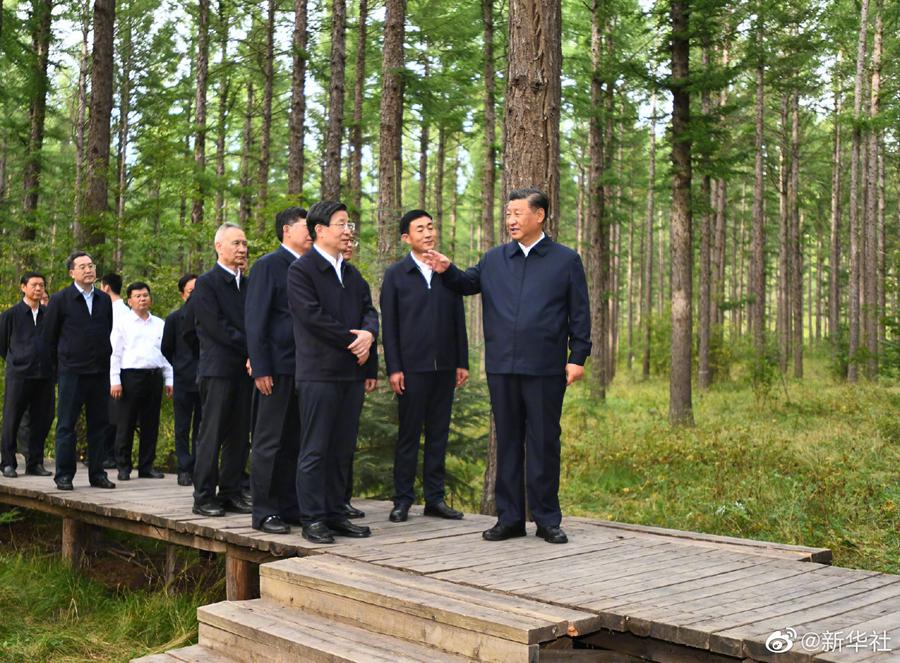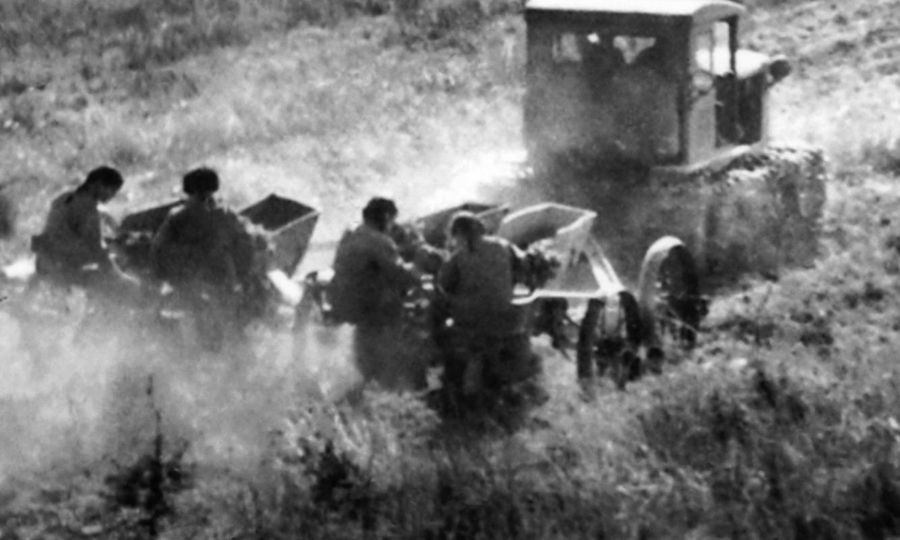President Xi Jinping on Monday visited the Saihanba forest farm in North China's Hebei Province, and toured the Shang Hai memorial forest to observe the growth of trees. He again stressed promoting Saihanba Spirit, which inspired workers to turn a barren desert into a lush forest.

President Xi Jinping visits the Saihanba forest farm on Monday. (Photo: Xinhua)
The Shang Hai memorial forest is located in the former Matikeng afforestation area. This is where the Saihanba miracle started.
The forest is named after Wang Shanghai, the first secretary of the Communist Party of China (CPC) committee of the farm. Before this assignment, Wang was director of the Bureau of Agriculture in Chengde. In 1961, he was assigned to Saihanba. He devoted the rest of his life to the area.

Tree farm workers in Matikeng in 1964 (File photo)
In the beginning, life in Saihanba was extremely difficult. The terrain was freezing, windy and sandy. Wang moved with his wife and five children from their comfortable house in Chengde to a dormitory in Saihanba, bringing only a bookcase, two suitcases and several cookers with them. He led a group of 369 staff members, with an average age of 23.
In the eyes of other staff members, Wang did not seem like an official at all.
He did not put on airs, and his outfits were well-worn. Wang’s wife also worked, to help support the family. With many children, there was lack of food all the time.
In the face of tough living conditions, Wang’s wife tried to persuade him to go back to his hometown.
Wang said, “The forest farm is not built yet. Even if I die, I’d stay here.”

Newly planted woodland using mechanical afforestation in Matikeng (File photo)
There was always a gap between Wang’s ideals and reality.
In the first two years, the survival rate of the trees was only 8 percent. Some young staff members felt disappointed by this repeated failure. The Saihanba forest farm was in need of hope.
Wang insisted, “Since pine trees on the mountain survived, mechanical afforestation got to work as well.”
He put on his old fur coat, and rode on a reddish horse all over the farm to do field research.
In 1964, Wang surveyed Matikeng. The location was flat enough for mechanical afforestation. He picked more than 100 outstanding staff members to work there. Wang ordered that everyone should stay on site during the campaign.
In early spring, the temperature in Saihanba was below zero during daytime. The workers’ raincoats were spattered with mud and frozen stiff. Many young staff members hadn’t washed their faces for days.
Finally, Matikeng was planted with larches. This decision was a success. The deciduous conifers had a survival rate of 96.6 percent. Wang and his colleagues’ hard work paid off.
At Matikeng, where the campaign was carried out, the tall and dense pine trees formed a sea of forest. Now, after three generations of effort, the forest farm covers around 75,000 hectares, becoming the world's largest tree plantation.
The local forest coverage rate is as high as 80 percent, forging a solid ecological barrier to protect Beijing and Tianjin from sandstorms.

Planting trees in Matikeng in 1964 (File photo)
During the most difficult time, one of Wang’s friends asked him how long he would work in Saihanba. “I’ve chosen my graveyard in Matikeng,” said Wang.
Working in the harsh environment for years, Wang became ill. In 1989, he was stricken by a sudden myocardial infection.
On his deathbed in a hospital in Chengde, Wang pointed his hand to the north with difficulty, and said “Saihanba.” That was his last word to his family.
Wang’s ashes were scattered across Matikeng according to his last wish. The forest was named “the Shang Hai Memorial Forest.”
For decades, generations of Saihanba builders have worked hard and dedicated themselves to transforming the desert, where the "yellow sand covers the sky, the birds barely nest in the trees.” They turned the wasteland into a forest and wetland. Their deeds manifest the concept of green development, and reflect the Saihanba spirit.
(Translated by Cui Yijia, edited by Dong Feng and Sun Tianren; original story from Xinhua)


